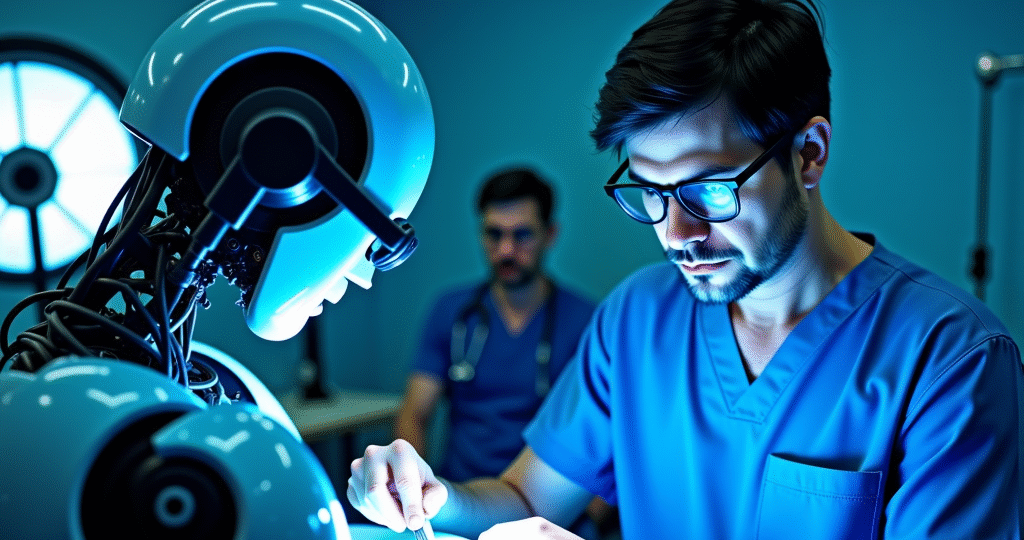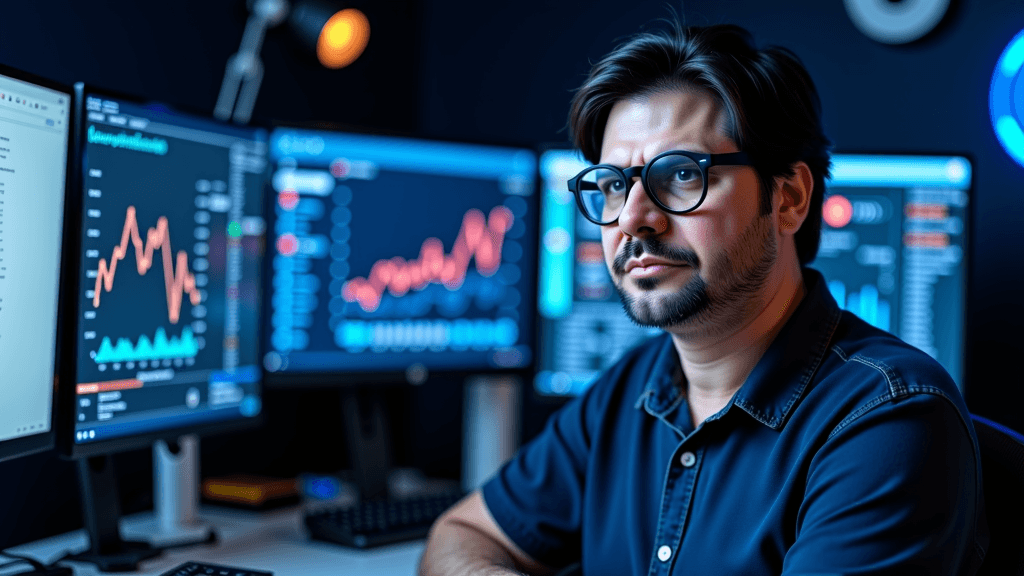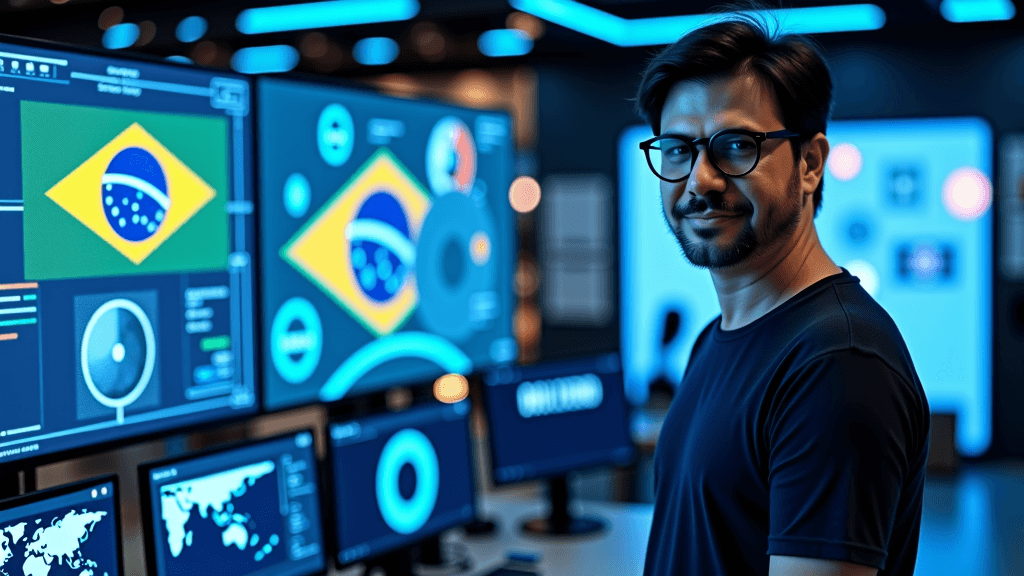History's First Fully Autonomous Robotic Surgery Takes Place as Brazil Structures AI Education — Why This Moment Defines the Future of Humanity
July 20, 2025 | by Matos AI

Yesterday, humanity crossed a line from which there can never be a turning back. For the first time in history, an artificially intelligent surgical robot performed complex surgery on human tissue without any direct intervention from doctors. This wasn't science fiction. It was real, it happened at Johns Hopkins University, and it marks the beginning of a new era.
While this was happening in the United States, here in Brazil, the Ministry of Education and UNESCO held a historic seminar to develop national benchmarks for the use of AI in basic education. Coincidence? I wouldn't say so. We are experiencing a moment of technological convergence that defines not only the future of medicine, but of society as a whole.
The Surgery That Changed Everything
The feat happened with the SRT-H (Hierarchical Surgical Robot Transformer), an evolution of the STAR robot. According to CNN Brazil, this machine doesn't just execute commands — it understands, decides, and adapts in real time during surgeries.
Join my WhatsApp groups! Daily updates with the most relevant news in the AI world and a vibrant community!
- AI for Business: focused on business and strategy.
- AI Builders: with a more technical and hands-on approach.
What impresses me most is the learning methodology. The robot was trained with videos of real operations accompanied by explanatory captions, learning 17 specific steps for gallbladder removal. During testing, it operated on eight gallbladders ex vivo with complete precision, even when faced with anatomical variations and simulated emergency situations.
Johns Hopkins professor Axel Krieger sums it up well: "To me, this really demonstrates that it's possible to perform complex surgical procedures autonomously. It's a robust proof of concept."
But here's the crux: using a learning architecture similar to ChatGPT, the robot learns from verbal commands and adapts during surgery. It's like having a resident being guided by a mentor, but with algorithmic precision.
Brazil at the Forefront of AI Education
While we celebrate this medical advancement, Brazil is making an equally historic decision in education. As reported by Future, the MEC and UNESCO seminar is building AI competency benchmarks for teachers and students.
What strikes me is the responsible approach. It's not just about introducing technology into schools, but keep teachers and students at the center of the process. It is exactly this humanized vision of technology that we need.
And Piauí surprises us by being a pioneer. According to the Future, became the first Brazilian state to fully implement an AI curriculum in the public school system, benefiting 120,000 students with a project designed for 30 years.
This isn't just public policy—it's forward-thinking.
The Labor Market Paradox
But not everything is rosy. A revealing study cited by InfoMoney shows that 90% of employers already use automation to screen candidates and 88% employ some form of AI in the selection process.
The problem? When candidates know that AI is evaluating them, they favor analytical traits and downplay human skills like empathy and creativity. We are creating a standardized generation just when we need more diversity.
This homogenization compromises organizational innovation. As I often say in my work with startups: diversity isn't just an ethical issue—it's a strategic competitive advantage.
Lessons from a Pioneer
A story that inspires me comes from the founders of Hera.Build, Barbara Vallim and Suzana Oliveira. According to the Poder360, they created a company focused on AI agents in January 2024, recovering the initial investment of R$200,000 in just one year.
Most importantly, they democratize AI for Brazilian and foreign companies, prioritizing data security and female inclusion in technology. It's precisely this kind of conscious entrepreneurship that we need to multiply.
Art, Ethics, and the Future of Creativity
I cannot fail to mention the prospect of Refik Anadol, which according to O Globo defines his work as "human-machine collaboration." He sees himself as a "spaceship pilot" in artistic creation, a perfect metaphor for our relationship with AI.
Anadol argues that AI doesn't reduce human creativity — it expands imagination. But the value is in human interpretation. This is what differentiates creation from automation.
The Risks We Cannot Ignore
It would be irresponsible to ignore the warnings. Financial analysts, as highlighted by NeoFeed, warn of a possible AI bubble bigger than the dot-com of the 1990s. The “Magnificent Seven” (Apple, Amazon, Alphabet, Meta, Microsoft, Tesla and Nvidia) are worth US$1.4 trillion — 311.3 trillion of the S&P 500.
Combined investment in AI will exceed US$320 billion by 2025. That's enough money to transform the world or create the largest speculative bubble in history. The difference lies in execution and practical application.
Why This Moment Is Unique
In my 25 years of following innovation ecosystems, I have rarely seen such perfect convergence between technological advancement, educational public policies and market opportunities. The current moment offers three simultaneous windows:
- Technological: AI has achieved true autonomous capability in complex tasks
- Educational: Brazil structures AI training from the ground up
- Economic: The market demands professionals fluent in AI
Whoever can navigate these three currents simultaneously will create sustainable competitive advantages. It's not about replacing humans—it's about amplifying human capabilities.
The CATS Method and the Democratization of Knowledge
Speaking of amplification, international experts shared in MediaTalks the CATS method for creating effective prompts:
- Context: detail scenery and background information
- Angle: define the role or perspective of AI
- Task: clearly explain the objective
- Style: indicate desired format, tone and voice
This democratization of AI knowledge is crucial. There's no point in having robots perform surgeries if people don't know how to effectively interact with these technologies.
Reflections of an Entrepreneur
As someone who has supported over 10,000 startups and followed the technological evolution of recent decades, I see interesting parallels. The internet in the 1990s promised to connect the world—and it did, but it also created filter bubbles. AI promises to amplify human intelligence—and it does, but it can also standardize thoughts.
The difference is in the intentionality. When we work with startups undergoing acceleration, I always emphasize: technology is a tool, not an end in itself. The value lies in solving real problems for real people.
This autonomous robotic surgery isn't just impressive because of the technology—it's impressive because it can save lives, reduce medical errors, and democratize access to quality procedures. technology with purpose.
The Future We Choose to Build
We are in a moment of collective choice. We can use AI to standardize, control, and replace—or to personalize, empower, and amplify. Johns Hopkins surgery, Piauí's curriculum, and the founders of Hera.Build point to the latter.
But this requires conscious leadership. It requires understanding that true innovation combines technological advancement with human development. It requires building bridges between what is technically possible and what is socially desirable.
As I said in a recent talk: “It’s not about humans versus machines. It’s about humans and machines creating possibilities that neither could achieve alone.”
Your Historic Opportunity
If you've made it this far, you probably understand that we're living in a historic moment. The question isn't whether AI will transform your field—it's how you'll lead that transformation.
In my mentoring work, I've helped entrepreneurs and leaders identify practical opportunities for applying AI, always focusing on positive impact and sustainability. Because I believe the future belongs to those who can combine technological vision with human purpose.
The Johns Hopkins robot didn't operate alone—it was trained by humans, supervised by experts, and deployed to solve a real human problem. This is the AI worth building.
And you, how will you use this unique moment in history to create the impact the world needs?
✨Did you like it? You can sign up to receive 10K Digital's newsletters in your email, curated by me, with the best content about AI and business.
➡️ Join the 10K Community here
RELATED POSTS
View all



